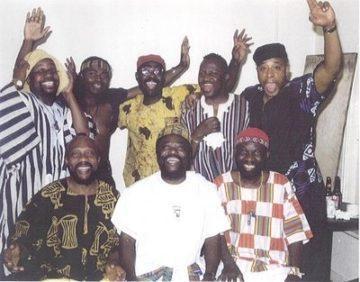INFORMATION
| Occupation(s) : | songwriter,sound engineer,producer |
| Genres : | afro pop,jazz,funk,rock ,latin,R&B |
Osibisa are a British Afro-pop band, founded in London in 1969 by four expatriate African and three Caribbean musicians.[1] Their music is a fusion of African, Caribbean, jazz, funk, rock, Latin, and R&B. Osibisa were one of the first African-heritage bands to become widely popular and linked with the establishment of world music as a marketable genre.
n Ghana in the 1950s, Teddy Osei (saxophone), Sol Amarfio (drums), Mamon Shareef, and Farhan Freere (flute) played in a highlife band called The Star Gazers. They left to form The Comets, with Osei’s brother Mac Tontoh on trumpet, and scored a hit in West Africa with their 1958 song “Pete Pete.” In 1962 Osei moved to London to study music on a scholarship from the Ghanaian government. In 1964 he formed Cat’s Paw, an early “world music” band that combined highlife, rock, and soul. In 1969 he persuaded Amarfio and Tontoh to join him in London, and Osibisa was born.
Joining them in the first incarnation were Grenadian Spartacus R (bass); Trinidadian Robert Bailey (keyboard); Antiguan Wendell Richardson (lead guitar & lead vocalist); and Nigerians Mike Odumosu and Fred Coker (bass guitar) and Lasisi Amao (percussionist and tenor saxophone). The band spent much of the 1970s touring the world, playing to large audiences in Japan, Australia, India, and Africa. During this time Paul Golly (guitar) and Ghanaians Daku Adams “Potato” and Kiki Gyan were also members of the band. In 1980 Osibisa performed at a special Zimbabwean independence celebration, and in 1983 were filmed onstage at the Marquee Club in London.
Changes in the music industry however (punk and disco primarily) meant declining sales for the band, and a series of label changes resulted. The band returned to Ghana to set up a recording studio and theatre complex to help younger highlife musicians. In the 1990s their music was widely anthologized in many CD collections, most of them unauthorized and paying no royalties whatsoever to the band.
In 1996 Osei reformed the band, and many of their past releases began coming out legally on CD. The revitalized band remains active, although Osei has cut back his touring schedule due to the effects of a stroke.
Osibisa had an energetic performance in India, at the November Fest 2010 on 28 November 2010 at the Corporation Kalaiarangam in Coimbatore, Tamil Nadu
The name Osibisa was described in lyrics, album notes and interviews as meaning “criss-cross rhythms that explode with happiness” but it actually comes from “osibisaba” the Fante word for highlife.[3][4] Their style influenced many of the emerging African musicians of the time and even now, as Ace Ghanaian hip-hop music producer Hammer of The Last Two stated that his debut production, Obrafour’s Pae Mu Ka album, the highest selling hiplife album to date was inspired by a single song (“Welcome Home”) by Osibisa. He also had the chance to work with Kiki Gyan a few days before his death.
Their first two albums featured artwork (and logo) by famed progressive-rock artist Roger Dean (before he became famous for his artwork), depicting flying elephants which became the symbol for the band. The third album, Heads, features a cover by Mati Klarwein, famed for his covers for Santana (Abraxas) and Miles Davis (Bitches Brew). Osibirock features “Negro Attacked by a Jaguar” (1910) by Henri Rousseau. Playing on the original flying elephants theme, the Ultimate Collection set features elephants with tank turrets for heads. In 2009, their Osee Yee album featured the flying elephants once more, this time painted by Freyja Dean (Dean’s daughter). Roger Dean’s logo for the band continues to be used on every release.


